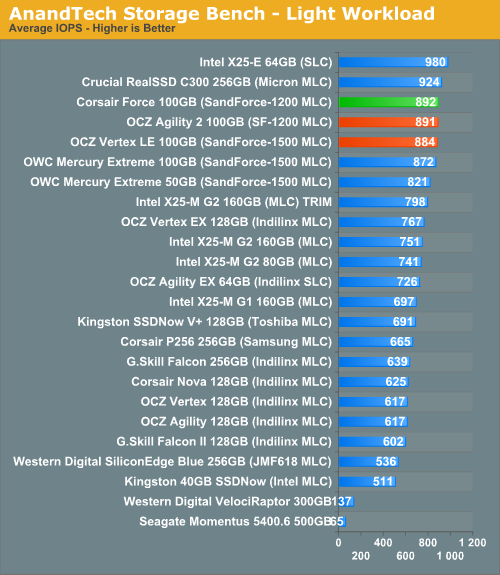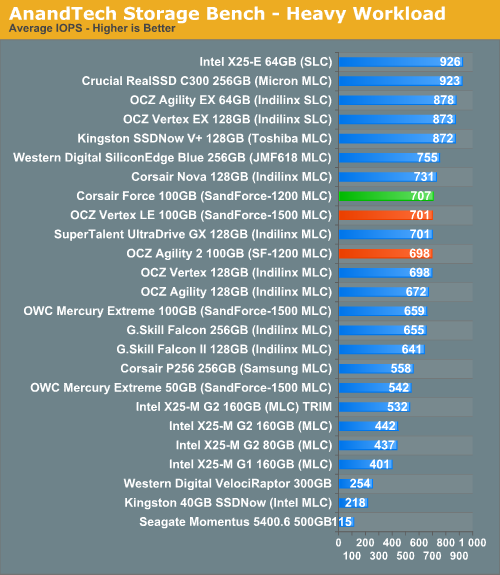OCZ's Agility 2 Reviewed: The First SF-1200 with MP Firmware
by Anand Lal Shimpi on April 21, 2010 7:22 PM ESTAnandTech Storage Bench
Note that our 6Gbps controller driver isn't supported by our custom storage bench here, so the C300 results are only offered in 3Gbps mode.
The first in our benchmark suite is a light usage case. The Windows 7 system is loaded with Firefox, Office 2007 and Adobe Reader among other applications. With Firefox we browse web pages like Facebook, AnandTech, Digg and other sites. Outlook is also running and we use it to check emails, create and send a message with a PDF attachment. Adobe Reader is used to view some PDFs. Excel 2007 is used to create a spreadsheet, graphs and save the document. The same goes for Word 2007. We open and step through a presentation in PowerPoint 2007 received as an email attachment before saving it to the desktop. Finally we watch a bit of a Firefly episode in Windows Media Player 11.
There’s some level of multitasking going on here but it’s not unreasonable by any means. Generally the application tasks proceed linearly, with the exception of things like web browsing which may happen in between one of the other tasks.
The recording is played back on all of our drives here today. Remember that we’re isolating disk performance, all we’re doing is playing back every single disk access that happened in that ~5 minute period of usage. The light workload is composed of 37,501 reads and 20,268 writes. Over 30% of the IOs are 4KB, 11% are 16KB, 22% are 32KB and approximately 13% are 64KB in size. Less than 30% of the operations are absolutely sequential in nature. Average queue depth is 6.09 IOs.
The performance results are reported in average I/O Operations per Second (IOPS):

It's not terribly surprising that we're not seeing any performance difference between the Agility 2 and other SandForce drives here. The only difference is in sustained random write performance and desktop workloads simply don't sustain purely random writes for that long a period.
If there’s a light usage case there’s bound to be a heavy one. In this test we have Microsoft Security Essentials running in the background with real time virus scanning enabled. We also perform a quick scan in the middle of the test. Firefox, Outlook, Excel, Word and Powerpoint are all used the same as they were in the light test. We add Photoshop CS4 to the mix, opening a bunch of 12MP images, editing them, then saving them as highly compressed JPGs for web publishing. Windows 7’s picture viewer is used to view a bunch of pictures on the hard drive. We use 7-zip to create and extract .7z archives. Downloading is also prominently featured in our heavy test; we download large files from the Internet during portions of the benchmark, as well as use uTorrent to grab a couple of torrents. Some of the applications in use are installed during the benchmark, Windows updates are also installed. Towards the end of the test we launch World of Warcraft, play for a few minutes, then delete the folder. This test also takes into account all of the disk accesses that happen while the OS is booting.
The benchmark is 22 minutes long and it consists of 128,895 read operations and 72,411 write operations. Roughly 44% of all IOs were sequential. Approximately 30% of all accesses were 4KB in size, 12% were 16KB in size, 14% were 32KB and 20% were 64KB. Average queue depth was 3.59.

Our heavy multitasking test definitely racks up the sequential writes, again we don't see any difference between the Agility 2 and other SandForce drives.
The gaming workload is made up of 75,206 read operations and only 4,592 write operations. Only 20% of the accesses are 4KB in size, nearly 40% are 64KB and 20% are 32KB. A whopping 69% of the IOs are sequential, meaning this is predominantly a sequential read benchmark. The average queue depth is 7.76 IOs.

Here we're completely bound by read performance.










60 Comments
View All Comments
529th - Thursday, April 22, 2010 - link
Some people are curious about the Vertex LE 50g version. Yes, I've read the Vertex LE 100g review :)50g Vertex LE: http://www.newegg.com/Product/Product.aspx?Item=N8...
New Egg's description says "For enthusiasts w/ up to 15,000 4KB random write IOPS" which would suggest the controller is the SF 1200 where as the Vertex LE SSD drives are suppose to have the SF 1500 controller which will do ~ 30,000 4kb so the inconsistency brings up curiosity. To make matters worse, The OCZ website says they use the SF 1500 controller. Which I vaguely recall someone saying they asked OWC which controller they were using for their OWC Mercury Extreme SSD drives and OWC's response was that they didn't know....
willscary - Thursday, April 22, 2010 - link
Originally, I was told by Customer Service that he "did not know", but after pressing for an answer and a breif period on hold, he returned and told me that all current and future Mercury Extreme SSDs would utilize the Sandforce 1200 controller.I was very angry at this "bait and switch" and returned my SSDs. Actually, they were in transit and I had OWC recall them. I have not yet received credit for them although they returned to OWC early Tuesday morning.
I will also say that OWC did send confirmation of the returns and said that the credit would be processed by the end of the week, so all is not bad.
I was asked "what the big deal was" on another thread. The way I see it, it would be like ordering an expensive sports car with a V6 and having it arrive with a turbocharged 4 cylinder. The performance may be the same, but there would then be the possibility of added maintenance costs, lesser reliability and a shorter lifespan. Add to that that the dealer would tell me that even though the smaller turbo option was $1,000 less than the V6, I should pay the same because performance really would be nearly identical.
Just my thoughts.
DanNeely - Thursday, April 22, 2010 - link
15k IOPs is higher than the SF1200 supports with a normal firmware. More likely I think would be something similar to intels 40GB drive where only half the controllers flash chip ports are filled and a full speed SF controller.poeticjustic - Thursday, April 22, 2010 - link
That was a really helpful and thorough article. Thank you for all this info.a few things that i wanted to ask.
-On the random read/write speed page and specifically on the 4k aligned random write, we don't see anywhere the intel x25-E performance. Obviously that is because the testing of the x25-E was performed in the past, when this kind of test wasn't performed. Is it safe to assume that the performance of the x25-E would be quite close to that of the 4k random write test (around 48MB/s)?? Since we see that mostly the new controllers are mostly affected.
-Furthermore, at least from what i've seen on eshops around in my country, the price of the z-drive m84 250GB and 500Gb has come closer to that of sata ssds. Still they are more expensive of course, but wouldn't it be a good idea to start seeing some z-drive performance on those tables for a direct comparison with the ssds and see whether the difference in their performance is bigger than the difference in their price? Just a thought.
Making an extra remark on the performance of SF controller during already compressed data plus the the random data perormance table was a pretty important addition and something we should pay attention to.
Thank you once again for a well built article.
eaw999 - Thursday, April 22, 2010 - link
correct, the x25-e, like -m, isn't affected drastically by alignment. you can expect slightly higher numbers with alignment, but nothing jaw-dropping. on the other hand, the x25-e positively rips at random writes at high queue depths, but that's not something you're likely to see often in desktop usage.krazyderek - Thursday, April 22, 2010 - link
When does this ever happen? isn't that sentence an oxymorron, the only thing i can think of it if you were installing several applications at the same time? and it would depend on the applications being installed too, since i think i remember hearing that games are very sequential nowkrazyderek - Thursday, April 22, 2010 - link
I DO see the importance when dealing with pre-compressed files like pictures and videos, i agree it would be nice to see a 0% 50% and 100% compressed figures to give people a good overview of things, but still, when would you see highly random sequential data?zdzichu - Thursday, April 22, 2010 - link
Sequentially speaks about data access pattern, highly random is about data itself. It is perfect description of writing movie to a disk - you are storing byte-by-byte and each byte is probably different that preceeding ones.zdzichu - Thursday, April 22, 2010 - link
I think you can skip non-aligned test in future. It is a corner case, not interesting at all.PubicTheHare - Thursday, April 22, 2010 - link
I'm pretty sure we're still 18-24 months away from having SSDs priced at a level that the average SSD-seeker is willing to spend.There will probably be an attractive price differential between what is available now and what price level the same will be available for in 12 months, but I really think it'll take a bit over a year to start seeing "attractive" pricing.
None of this stuff matters to me until Apple supports TRIM or garbage collection (I believe this is "OS-agnostic" TRIM, right?) comes to the drives with the best firmware and price/usable GB.
I just want a 256-300 GB SSD that I can leave 15% unpartitioned and throw into a MBP. I want it to scream.